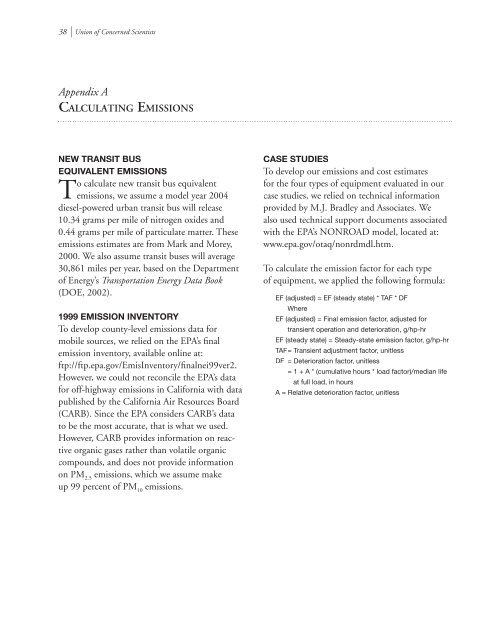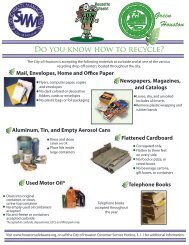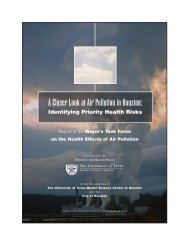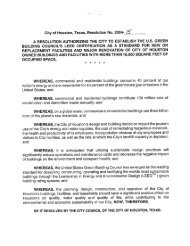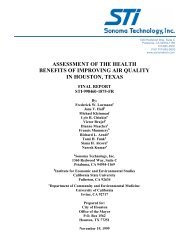38 l<strong>Union</strong> <strong>of</strong> <strong>Concerned</strong> <strong>Scientists</strong>Appendix ACALCULATING EMISSIONSNEW TRANSIT BUSEQUIVALENT EMISSIONSTo calculate new transit bus equivalentemissions, we assume a model year 2004diesel-powered urban transit bus will release10.34 grams per mile <strong>of</strong> nitrogen oxides and0.44 grams per mile <strong>of</strong> particulate matter. Theseemissions estimates are from Mark and Morey,2000. We also assume transit buses will average30,861 miles per year, based on the Department<strong>of</strong> Energy’s Transportation Energy Data Book(DOE, 2002).1999 EMISSION INVENTORYTo develop county-level emissions data formobile sources, we relied on the EPA’s finalemission inventory, available online at:ftp://ftp.epa.gov/EmisInventory/finalnei99ver2.However, we could not reconcile the EPA’s datafor <strong>of</strong>f-highway emissions in California with datapublished by the California Air Resources Board(CARB). Since the EPA considers CARB’s datato be the most accurate, that is what we used.However, CARB provides information on reactiveorganic gases rather than volatile organiccompounds, and does not provide informationon PM 2.5emissions, which we assume makeup 99 percent <strong>of</strong> PM 10emissions.CASE STUDIESTo develop our emissions and cost estimatesfor the four types <strong>of</strong> equipment evaluated in ourcase studies, we relied on technical informationprovided by M.J. Bradley and Associates. Wealso used technical support documents associatedwith the EPA’s NONROAD model, located at:www.epa.gov/otaq/nonrdmdl.htm.To calculate the emission factor for each type<strong>of</strong> equipment, we applied the following formula:EF (adjusted) = EF (steady state) * TAF * DFWhereEF (adjusted) = Final emission factor, adjusted fortransient operation and deterioration, g/hp-hrEF (steady state) = Steady-state emission factor, g/hp-hrTAF= Transient adjustment factor, unitlessDF = Deterioration factor, unitless= 1 + A * (cumulative hours * load factor)/median lifeat full load, in hoursA = Relative deterioration factor, unitless
<strong>Cleaning</strong> <strong>Up</strong> <strong>Diesel</strong> <strong>Pollution</strong> l 39Appendix BSTATE FACT SHEETS: AIR POLLUTION FROM MOBILE SOURCESDefinitionsPM10PM2.5NOxSO 2VOCROGCOLNGCNGParticulate matter less than or equal to 10 microns in diameterParticulate matter less than or equal to 2.5 microns in diameterNitrogen oxidesSulfur dioxideVolatile organic compounds (for all states except California)Reactive organic compounds (for California only)Carbon monoxideLiquefied natural gasCompressed natural gasSOURCE: All mobile source emission data except California’s <strong>of</strong>f-highway pollution are based on the final 1999 emission inventory compiled by the U.S. EPA. The dataare located online at: ftp://ftp.epa.gov/EmisInventory/finalnei99ver2/criteria. California’s <strong>of</strong>f-highway emissions were provided by the California Air Resources Board.U.S. TOTAL1999 Emissions in Tons per YearPM10 PM2.5 NOx SO2 VOC COMobile Sources - TOTAL 571,878 489,125 12,617,563 741,785 8,066,635 90,357,081Highway Vehicles 241,671 184,820 8,368,821 300,912 5,581,249 68,317,145Off-Highway Equipment and Vehicles 330,206 304,305 4,248,742 440,873 2,485,386 22,039,935Heavy Equipment (<strong>Diesel</strong>) 187,634 173,627 1,726,304 219,815 223,992 1,012,094Heavy Equipment (Gasoline) 67,294 62,164 178,163 9,403 2,141,901 19,464,538Heavy Equipment (LNG & CNG) 1,164 1,164 254,268 246 3,191 986,834Marine Vessels (<strong>Diesel</strong>) 44,335 40,836 904,313 174,705 30,201 120,560Railroads (<strong>Diesel</strong>) 23,317 21,265 1,078,939 28,444 41,569 111,593Aircraft 6,463 5,250 106,755 8,259 44,533 344,316Off-Highway <strong>Diesel</strong> 255,286 235,728 3,709,556 422,965 295,761 1,244,247Off-Highway (Other Fuels) 74,921 68,577 539,185 17,909 2,189,625 20,795,688Off-Highway Share <strong>of</strong> Mobile Source <strong>Pollution</strong> 58% 62% 34% 59% 31% 24%Off-Highway <strong>Diesel</strong> Share <strong>of</strong> Mobile Source <strong>Pollution</strong> 45% 48% 29% 57% 4% 1%Off-Highway Heavy <strong>Diesel</strong> Equipment Share <strong>of</strong> Mobile Source <strong>Pollution</strong> 33% 36% 14% 30% 3% 1%Heavy Equipment (<strong>Diesel</strong>) 187,634 173,627 1,726,304 219,815 223,992 1,012,094Agriculture 76,774 70,884 577,012 65,875 78,227 353,724Airport Ground Support 770 716 10,582 1,015 1,569 9,431Commercial 9,655 8,938 72,490 10,061 13,568 49,592Construction 77,143 71,510 832,888 109,528 100,093 479,928Industrial 14,581 13,538 139,425 20,571 18,252 72,642Lawn and Garden 4,657 4,296 38,501 5,405 6,980 23,084Logging 2,083 1,934 26,860 3,651 2,360 12,253Recreational 379 346 1,661 218 580 2,339Underground Mining 513 472 3,402 354 747 2,855Pleasure Craft 607 560 20,646 2,796 1,024 3,673Railroad Equipment 472 434 2,838 342 591 2,573


